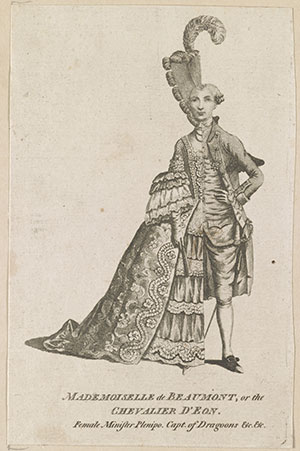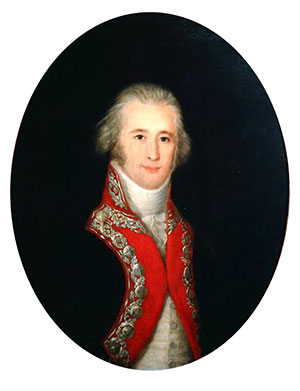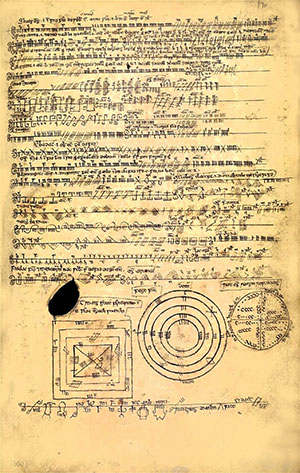ANTIQUARIES: Wine, genealogy and cross-dressing
Published in 18th-19th Century Social Perspectives, Features, Issue 5 (September/October 2018), Volume 26The chevalier brothers-in-law—Thomas O’Gorman, antiquary, genealogist and wine merchant, and Charles-Geneviève d’Éon de Beaumont, transgender diplomat and spy.
By Seán O’Halloran

Above: Contemporary print of ‘Mademoiselle de Beaumont, or the Chevalier d’Éon’.
The publication of a recently discovered copy of the manuscript of the genealogy of the house of O’Reilly by Clachan Publishing has drawn attention to its compiler, the largely forgotten eighteenth-century antiquary Chevalier Thomas O’Gorman (1732–1809), and his relationship with his French brother-in-law, Chevalier d’Eon, now an icon of the LGBT community. The genealogy was commissioned in the early 1790s by Alexander O’Reilly, an exiled Irish nobleman with the Spanish title of Condé de O’Reilly, to ‘establish’ the ancient lineage of the house of O’Reilly on the marriage of his eldest son to a Spanish countess. Count O’Reilly was a truly international figure, at various times a field marshal in the Spanish army, governor of Madrid and inspector-general of infantry, governor of Cadiz and captain-general of Andalusia.
O’Gorman’s background
O’Gorman was well qualified for the job. A fluent Irish-speaker, he was brought up in the Burren law school tradition. One of his own manuscripts describes him thus:
‘Chevalier Tomas O’Gorman, captain of Infantry in his Most Christian Majesty’s service, Knight of the Royal and Military order of St Louis. Born in Castletown, Co. Clare, 16 September 1732. Father was Mathew O’Gorman or MacGorman, who died in June 1740, aged 35 and who married in 1731 Margaret, daughter of Donogh O’Laughlin of Castletown in the Barony of Burren Esq. and of Coalia, daughter of Donogh O’Brien of Newtown in said Barony.’
He came from a substantial family, connected to Thomond’s oldest families—the Gaelic O’Briens and the Norman de Lacys. They occupied the territory of Drumelihy and Cahermurphy in the Burren. Thomas O’Gorman’s grandfather, however, had been convicted of high treason and his lands confiscated. Forty years later his grandson, Thomas, enrolled as a medical student in Paris and subsequently joined the Irish Brigade. Catholic continental Europe offered the only opportunities for well-connected young Irish men who were excluded from advancement at home. The defeat of the Jacobite cause in 1691 resulted in the wholesale flight of the leading Irish lords and a stream of fellow Irishmen.
The young Thomas had no doubt grown up with stories of his family’s former glory and had probably spied out the outsiders who occupied his family estates. His was a generation that had grown up with a sense of dispossession, not just of lost estates but also of the Gaelic way of life. A grandiloquent poem written possibly by Theophilus O’Flanagan (1762–1814) gives a flavour of the pride that must have sustained the ambitions and aspirations of the O’Gormans.
‘The battle’s front, the rear from havoc’s field
To you, O’Gorman’s Race, the world doth yield;
Loud thund’ring sounds the prancing of your steeds,
You stand unrivalled in all glorious deeds.’
Young Thomas gained admission to the Collège Mazarin with the assistance of Lord Viscount Clare, commander of a regiment of the Irish Brigade. He qualified as a medical doctor and advanced his knowledge of Latin and Greek. His personal passion, however, was to find and preserve literary material from Ireland’s embattled Gaelic past. He was thus greatly valued by the exiled Irish Jacobites as a compiler of genealogies to substantiate their right to preferment and to be recognised as exiled nobility.
O’Gorman personified the typical expatriated Irish Jacobite, engaged in war, wine and, of course, genealogy. These were not his only interests, however. As a tall and strikingly handsome medical student he caught the eye of Marguerite Françoise-Victoire d’Éon de Beaumont, daughter of Louis d’Éon de Beaumont, Burgundy.
Transgender brother-in-law

Above: Count Alexander O’Reilly, who, on the marriage of his eldest son to a Spanish countess, commissioned Thomas O’Gorman to compile a genealogy of his family to ‘establish’ its ancient lineage.
It has been claimed that Marguerite and O’Gorman eloped, so outraging her father that, in order to thwart the possibility of O’Gorman’s inheriting his estates, he claimed that his androgynous younger daughter, Charles-Geneviève, was a man and sent him/her off to military school. This, however, conflicts with a biography written in 1779, which states that she was dressed in boy’s clothes from childhood. Nevertheless, that Charles-Geneviève (hereafter referred to as d’Éon) was transgender is not in doubt. S/he was born in Tonnerre, Burgundy, in 1728, took a law degree as a male and came to the notice of Louis XV’s court, possibly through the assistance of O’Gorman, who was on good terms with King Louis, his eldest son being a page to the king. Correspondence between them indicate that O’Gorman actively took steps to promote d’Éon at court.
Extraordinarily, there were various possibilities involving cross-dressing in the raunchy court of Versailles. It is claimed that in 1755 d’Éon, dressed as a woman, attended a ball at Versailles, where, ‘after briefly revealing his masculinity, [he] seduced Madame de Pompadour’. Also in that year, according to a letter from d’Éon to O’Gorman, Madame de Pompadour subjected Louis XV to a ‘killingly funny scene’. D’Éon had gone to a ball ‘in female dress’; Louis mistook him for a jeune fille and, as d’Éon later recounts, ‘never expected to find what he did under my dress’.
Espionage
Such intrigues were not confined to the bedroom. D’Éon was recruited into King Louis’s diplomatic and espionage services, where his cross-dressing served him well. Between 1756 and 1760 he was involved in creating an alliance between France and Russia and served with distinction as a captain of dragoons, being awarded, like O’Gorman, the Cross of St Louis.
D’Éon then served in London as a diplomat involved in negotiating the Treaty of Paris in 1763, which ended the Seven Years War between France and Britain. In 1764 and 1765 he lived in Westminster under the name ‘Madame Duval’, perhaps in his capacity as a spy and to conceal himself from enemies. He lived lavishly, mixing with the likes of Horace Walpole and David Hume. He quarrelled with the French ambassador, however, and was dismissed from his official position. Intriguingly, from 1771 rumours began to circulate that d’Éon was really a woman and bets were placed on his/her true sex. In self-defence s/he threatened to use documents s/he possessed to blackmail her/his enemies. King Louis XV became alarmed and an official was sent to England to investigate. D’Éon ‘admitted’ that s/he was a woman, a fact reported to Louis XV, which, if the account of d’Éon’s earlier encounter with him is true, Louis may have had reason to doubt!
When the king died in 1774, his successor, Louis XVI, disbanded the king’s secret service and d’Éon was recalled to France, where s/he signed a document called the ‘Transaction’, the terms of which gave d’Éon a safe conduct and a pension. In return s/he handed over secret papers and agreed to resume women’s clothing, effectively closing the door on future military or diplomatic roles and concealing her/him from enemies.
Wine and genealogy

Above: Benjamin Franklin, American ambassador in Paris, 1776–85—O’Gorman told Franklin of his desire to become French consul in Philadelphia. (White House Historical Association)
In the meantime, O’Gorman and his wife had been deeply involved in the d’Éon family wine business. The couple, along with d’Eon, had inherited the family estate, of which O’Gorman had the largest acreage. The wines went to Parisian, Irish and Flemish merchants and to a select clientele, including the earl of Inchiquin and Benjamin Franklin, then ambassador to France. Interestingly, O’Gorman wrote the following to Franklin: ‘I beg you’ll inform me of whatever good News you have from the other side of the Atlantic. You know my sincere good Wishes for the Cause and my ardent desire of becoming one day or other a good subject of yours [sic].’ He also wrote to Franklin expressing his desire to become French consul in Philadelphia, citing his status as a naturalised Frenchman ‘with a French heart’ and his fluency in several languages, ‘notably those used in America’.
Over the years the wine trade gave O’Gorman opportunities to visit Ireland, where he travelled through counties Clare, Limerick and Tipperary, gathering manuscripts, copying tombstone inscriptions and involving himself in the Gaelic cultural revival. In 1782 he was commissioned by Henry McNamara to compile his family’s genealogy. As well as for Count O’Reilly, he compiled genealogies for the MacCarthys of Toulouse, the Butlers of Rochelle, the O’Neils, Roches and Kearneys of County Clare, and the de Lacy MacMahons. This work also placed him at the centre of bitter family quarrels, as with the disputed claim to the title of earl of Thomond between Charles O’Brien, 6th Viscount, and Daniel O’Brien, the earl of Lismore.
O’Connells of Derrynane
Count Daniel Charles O’Connell, despite his brilliant military record in the Irish Brigade, could not obtain promotion until he had proven to the satisfaction of the French herald’s office that his family ranked among the nobility. In a letter to his wealthy brother, Maurice ‘Hunting Cap’ O’Connell of Derrynane, he wrote: ‘It’s indispensably necessary to be present at court to roll with the nobility; and to be admitted to that honour a genealogy must be produced’. The services of O’Gorman were obtained and Count O’Connell wrote: ‘This gentleman is a perfect master of all matters relating to Irish pedigrees. He has made out all those Irishmen who, within some years past, have been admitted and passed as authentic in the Herald’s office.’ His tight-fisted brother in Kerry (who wore a hunting cap because the more fashionable beaver hat was taxed) would not part with the £300 required, but the count managed to secure the sum from an Irish soldier friend and O’Gorman produced the necessary document, albeit including a few spurious details. It satisfied the herald’s office, however, and the promotion followed. Fortunately, Maurice was not so tight-fisted with his nephew, Daniel. His patronage enabled the latter to study law in Paris and later to become known as ‘the Liberator’.
Serious antiquarian

Above: A page from the Book of Ballymote, which became O’Gorman’s property when he purchased it for £20 from a millwright’s widow in Drogheda. O’Gorman deciphered and translated the ogham script. Cathal Ó Conchobhair of Belanagare (the O’Conor Don), the leading expert on Irish manuscripts at the time, determined that it was written under the partonage of Timothy Mac Donogh, chief of Tír-Olioll, Artagh, and was transcribed c. 1390, when Torlogh O’Connor was king of Connaught. It was purchased from the Mac Donoghs of Coran by Hugh Duff Ó Donell, prince of Tirconnell, in 1522 for 140 milch cows. (RIA)
Some have seen O’Gorman as a royalist spin-doctor of the exiled Irish nobility, courtier in Versailles and perhaps opportunistic supporter of the American Revolution. Nevertheless, his interest in Irish antiquities was genuine and very productive. In 1772 he attended a meeting of the Dublin Society’s committee of antiquaries, where he informed them that he had seen a copy of the Book of Lecan in the Irish College in Paris. The Dublin Society authorised him to apply to the College of the Lombards in Paris and other bodies to make copies of manuscripts removed from Ireland. He also contributed to Charles Vallancey’s Grammar of the Irish language (1773).
O’Gorman presented the Book of Ballymote to the Royal Irish Academy in 1785. It apparently became his property when he purchased it for £20 from a millwright’s widow in Drogheda. Furthermore, drawing on his connections with exiled Gaelic aristocracy, he was involved in tracking down ‘Brian Boru’s harp’, which was presented to Trinity College, Dublin. Ironically, the search received financial assistance from William Burton Conyngham, a descendant of the family that was granted the O’Gormans’ confiscated estate.
Epilogue
As for d’Éon, on returning to Tonnerre in 1779 s/he threw her/himself into the task of developing the family’s vineyards, availing of O’Gorman’s advice and producing high-quality as well as more ordinary wines. The French Revolution changed their lives, however; their vineyards were confiscated and d’Éon’s pension ended. S/he returned to London, was imprisoned for debt and subsequently earned a living through unedifying circus-like public performances duelling as a woman. S/he died in 1810, the autopsy revealing that s/he had ‘male organs in every respect perfectly formed’, while at the same time displaying feminine characteristics such as rounded limbs and ‘breasts remarkably full’. S/he has become an icon of the LGBT community and perhaps Europe’s first publicly acknowledged transgender person. The Beaumont Society, a British transgender and cross-dressing support organisation, is named after her/him. There are even Japanese animé and manga fictionalised series based very loosely on d’Éon’s sensationalised life.

Above: ‘Brian Boru’s harp’ in the Old Library, Trinity College, Dublin. Drawing on his connections with exiled Gaelic aristocracy, O’Gorman was involved in tracking it down, with financial assistance from William Burton Conyngham, who presented it to the College in 1782. (TCD)
The Reign of Terror in 1793 saw a destitute O’Gorman return to Ireland. He lived for a while in Dublin, where he was badgered by bailiffs and arrested by Dublin Castle for ‘traitorous correspondence’ with the French. His protestations that he had ‘three sons fighting for His Majesty King George’ brought about his release and he returned to his birthplace at Drumelihy, where no doubt he reflected on the gulf between his present situation and his glittering days as companion to King Louis in Versailles. He died in 1809 and was buried in Kilmacdouane, Co. Clare. He is remembered in Tonnerre, however, where his former residence, now known as the Chevalier O’Gorman Hotel, hosts guided tours on heritage days. There is no memorial to him in Ireland.
Seán O’Halloran is a retired lecturer in TESOL and linguistics (Singapore, Hong Kong and Ireland) and is director of Clachan Publishing.
Read More Book of Ballymote
FURTHER READING
- Burrows, J. Conlin & R. Goulbourne (eds), The Chevalier d’Eon and his worlds: gender, espionage and politics in the eighteenth century (London, 2010).
- Harbison, ‘O’Gorman, Thomas (“The Chevalier”)’, in Dictionary of Irish Biography (Cambridge, 2009).
- Hayes, ‘A forgotten Irish antiquary: Chevalier Thomas O’Gorman 1732–1809’, Studies 30 (1941), 587–96.
















